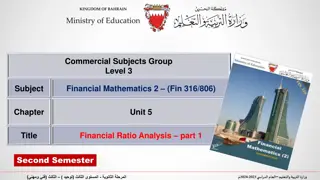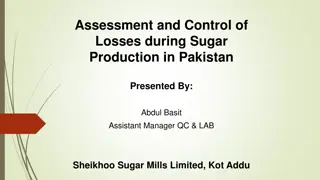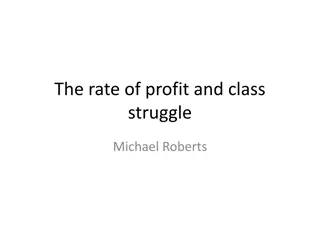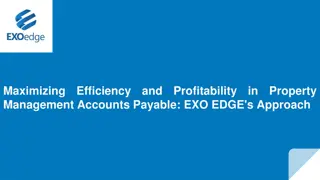MEASURING PROFITABILITY
In this topic, learn about measuring profitability through profit margins and return on capital employed. Dive into ratio analysis for detailed financial comparisons, benchmarking, and understanding business performance. Explore the importance of numbers in evaluating financial health. Practice with real-world examples to enhance your financial analysis skills.
Download Presentation

Please find below an Image/Link to download the presentation.
The content on the website is provided AS IS for your information and personal use only. It may not be sold, licensed, or shared on other websites without obtaining consent from the author.If you encounter any issues during the download, it is possible that the publisher has removed the file from their server.
You are allowed to download the files provided on this website for personal or commercial use, subject to the condition that they are used lawfully. All files are the property of their respective owners.
The content on the website is provided AS IS for your information and personal use only. It may not be sold, licensed, or shared on other websites without obtaining consent from the author.
E N D
Presentation Transcript
F3 MEASURING PROFITABILITY Discussion: Company A has sales of 1m and profit of 100 000. Company B has sales of 500 000 and profits of 80 000. Which one is the most profitable? What is the difference between profit and profitable? MEASURING PROFITABILITY
MEASURING PROFITABILITY In this topic you will learn about Calculation, interpretation, analysis and evaluation of: Gross profit margin: (gross profit/revenue) x 100 Mark-up: (gross profit/cost of sales) x 100 Profit margin: (profit/revenue) x100 Return on capital employed (ROCE): (profit/capital employed) x 100
RATIO ANALYSIS Allows for a more meaningful analysis of published accounts What is meant by the term benchmark? Shows relationship between figures Used for comparisons over time Inter and intra business comparisons Intra means between businesses e.g. to compare performance to competitors or to benchmark Why are numbers so important when understanding a business performance? View M&S key facts. Inter means within a business e.g. over time within one organisation or between branches
MEASURINGPROFITABILITY Gross profit margin (GPM) is a measure of a firm s profitability by looking at the relationship between gross profit and revenue If GPM is low or falling this may indicate that a firm is not managing its cost of sales effectively e.g. are the cost of raw materials increasing? sales are in decline Calculated as: Gross profit Revenue x 100 Example: Revenue Cost of goods sold = 15 750 Gross profit Gross profit margin = 35 000 = 19 250 ( 35 000 - 15 750) = 19 250/ 35 000 x 100 = 55%
MEASURINGPROFITABILITY Profit margin (or operating profit margin) is a measure of a firm s profitability by looking at the relationship between operating profit and revenue If OPM is low or falling this may indicate that a firm is not managing its expenses effectively e.g. wages are increasing or overheads are going up sales are in decline Calculated as: Profit Revenue x 100 Example: Revenue Gross profit Expenses Operating profit Operating profit margin = 13 300/ 35 000 x 100 = 38% = 35 000 = 19 250 = 5 950 = 13 300
PRACTICEQUESTION Using the extract from SuperGroup Plc s statement of comprehensive income calculate: a) Gross profit margin b) Profit margin View full statement of comprehensive income. Comment on the financial performance of SuperGroup Plc.
MEASURINGPROFITABILITY Mark-up is a measure of a firm s profitability by looking at the relationship between gross profit and cost of sales Cost of sales and cost of goods sold are interchangeable terms. If mark-up is low this may indicate that the firm is not managing its cost of sales effectively e.g. raw material costs are too high is in a highly competitive market where firms compete on price Calculated as: Gross profit Cost of sales x 100 Example: Revenue Cost of sales Gross profit Mark-up = 35 000 = 15 750 = 19 250 ( 35 000 - 15 750) = 19 250/ 15 750 x 100 = 112%
MEASURINGPROFITABILITY Return on Capital Employed (ROCE) Challenge: Capital employed can also be calculated as total assets minus current liabilities. Can you explain why? A measure of how efficiently a business is using capital employed to generate profits Capital employed = total equity + non-current liabilities i.e. all the money invested in the business from: Share capital Reserves Long term loans Formula: Operating profit x 100 Total equity + non-current liabilities
RETURNONCAPITALEMPLOYED Statement of financial position Non-current assets Inventories Trade receivables Cash & cash equivalents 2300 Total current assets Current liabilities Net current liabilities Non-current liabilities Net assets m 19550 2375 Statement of comprehensive income m Revenue Cost of sales Gross profit Expenses Operating profit Finance income Finance cost Profit before tax Taxation Profit for the year (30100) 5300 35400 1170 5845 (8160) (2315) (6000) 11235 (720) 4580 300 (260) 4620 (1109) 3511 Owner s capital Reserves & retained earnings Total equity 6000 5235 11235 Operating profit x 100 Total equity + non-current liabilities 4580 x 100 11235 + 6000 4580 x 100 = 27% 17235
INTERPRETATIONOF ROCE Why would it be meaningful to compare this to the current rate of interest? Why might a high street retailer compare ROCE between individual stores? Return on capital employed Operating profit x 100 total equity + non-current liabilities 4580 X 100 = 27% 17235 For every 1 of capital employed in the business 27 pence is generated in operating profit. NB A statement of financial position may be presented showing capital employed in which case the bottom line of the formula is capital employed. Capital employed = total equity + non-current liabilities.
MEASURING PROFITABILITY In this topic you have learnt about Calculation, interpretation, analysis and evaluation of: Gross profit margin: (gross profit/revenue) x 100 Mark-up: (gross profit/cost of sales) x 100 Profit margin: (profit/revenue) x100 Return on capital employed (ROCE): (profit/capital employed) x 100























